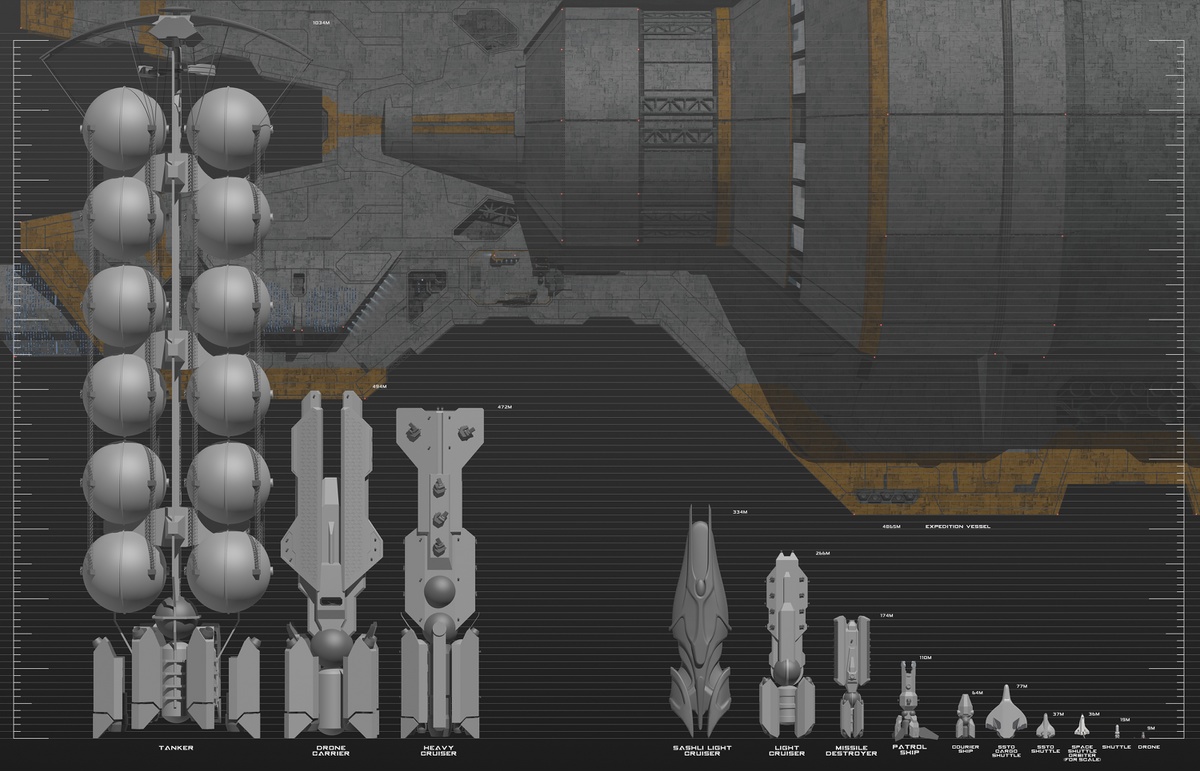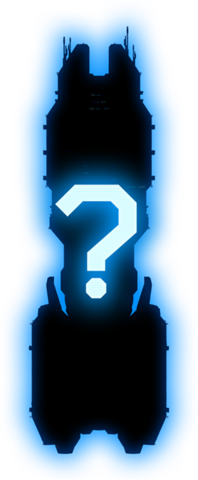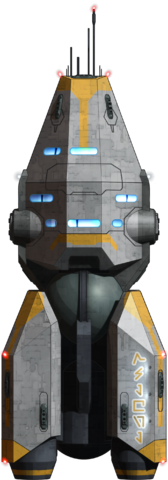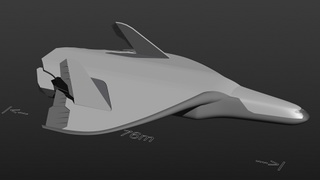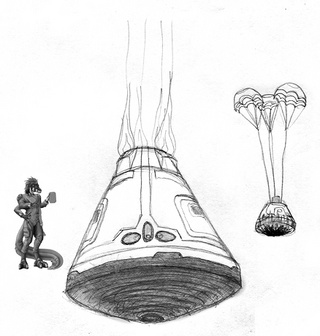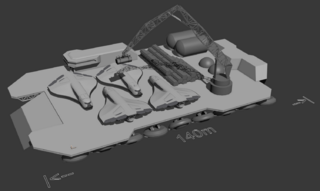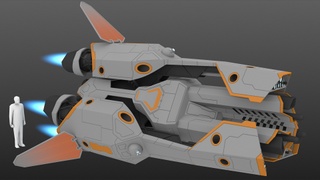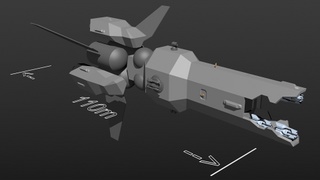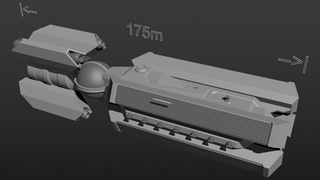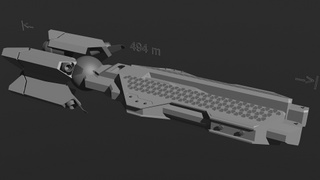Difference between revisions of "Spaceships"
| (6 intermediate revisions by the same user not shown) | |||
| Line 14: | Line 14: | ||
==Heavy Ships(Core ships)== | ==Heavy Ships(Core ships)== | ||
Ships with a length of over 1 kilometer and with a crew numbered in more than a thousand members. These ships form the core of the military and expeditionary fleets (Named | Ships with a length of over 1 kilometer and with a crew numbered in more than a thousand members. These ships form the core of the military and expeditionary fleets (Named "Core Ships" in this case), providing docks and manufacturing capabilities to issue maintenance and repair of other ships, enabling the entire fleet to operate away from supply bases for extended periods. | ||
=== | ===Motherships=== | ||
The largest of ships, crews (or, rather, 'population') can reach up to hundreds of thousands, and ships themselves are kilometers long. These are the largest ships that exist in the galaxy and are usually prided as jewels of the technological prowess of the ship's builders. Usually, they're fully autonomous and require only raw materials for functionality. | The largest of ships, crews (or, rather, 'population') can reach up to hundreds of thousands, and ships themselves are kilometers-long. These are the largest ships that exist in the galaxy and are usually prided as jewels of the technological prowess of the ship's builders. Usually, they're fully autonomous and require only raw materials for functionality. | ||
==Space constructs and stations== | ==Space constructs and stations== | ||
| Line 41: | Line 41: | ||
|Lang = en | |Lang = en | ||
|Width= 70% | |Width= 70% | ||
|Image = | |Image = default_ship.png | ||
|Name = Arrow | |Name = Arrow | ||
|Class = Light ship | |Class = Light ship | ||
| Line 69: | Line 69: | ||
|Lang = en | |Lang = en | ||
|Width= 70% | |Width= 70% | ||
|Image = | |Image = default_ship.png | ||
|Name = Pillar | |Name = Pillar | ||
|Class = Main ship | |Class = Main ship | ||
| Line 98: | Line 98: | ||
|Lang = en | |Lang = en | ||
|Width= 70% | |Width= 70% | ||
|Image = | |Image = tanker_ortho.png | ||
|Name = Lake | |Name = Lake | ||
|Class = Heavy ship | |Class = Heavy ship | ||
| Line 126: | Line 126: | ||
|Lang = en | |Lang = en | ||
|Width= 70% | |Width= 70% | ||
|Image = | |Image = mothership_ortho.png | ||
|Name = [[Dawn_Mothership|Dawn]] | |Name = [[Dawn_Mothership|Dawn]] | ||
|Class = Core ship | |Class = Core ship | ||
| Line 134: | Line 134: | ||
|Mass = 2,2 Bln tonnes | |Mass = 2,2 Bln tonnes | ||
|Crew = 466 | |Crew = 466 | ||
|Pass = | |Pass = 10 000 - 50 000 (Drum only) | ||
|Grav = centrifugal | |Grav = centrifugal | ||
|Autonomy = 10 years | |Autonomy = 10 years | ||
| Line 145: | Line 145: | ||
{{bull}}60 shuttles<br> | {{bull}}60 shuttles<br> | ||
{{bull}}20 atmospheric shuttles<br> | {{bull}}20 atmospheric shuttles<br> | ||
{{bull}} | {{bull}}4 cargo shuttles<br> | ||
{{bull}}4 orbital barges<br> | {{bull}}4 orbital barges<br> | ||
{{bull}}3 shipyards for docking and repair of other ships<br> | {{bull}}3 shipyards for docking and repair of other ships<br> | ||
| Line 160: | Line 160: | ||
|Lang = en | |Lang = en | ||
|Width= 70% | |Width= 70% | ||
|Image = | |Image = Courier_ortho.png | ||
|Name = Signal | |Name = Signal | ||
|Class = Light Ship | |Class = Light Ship | ||
|Role = Courier ship | |Role = Courier ship | ||
|Length = | |Length = 75 m | ||
|Agility = high | |Agility = high | ||
|Mass = 1070 tonnes | |Mass = 1070 tonnes | ||
| Line 189: | Line 189: | ||
|Lang = en | |Lang = en | ||
|Width= 70% | |Width= 70% | ||
|Image = | |Image = Shuttle_ortho.png | ||
|Name = Candle | |Name = Candle | ||
|Class = Light ship | |Class = Light ship | ||
| Line 244: | Line 244: | ||
|Lang = en | |Lang = en | ||
|Width= 70% | |Width= 70% | ||
|Image = | |Image = intershuttle_ortho.png | ||
|Name = Drone | |Name = Drone | ||
|Class = Light ship | |Class = Light ship | ||
| Line 357: | Line 357: | ||
}} | }} | ||
=== | ===Main=== | ||
====Patrol ship==== | ====Patrol ship==== | ||
| Line 425: | Line 425: | ||
|Lang = en | |Lang = en | ||
|Width= 70% | |Width= 70% | ||
|Image = | |Image = cruiser_ortho.png | ||
|Name = Flame | |Name = Flame | ||
|Class = Main ship | |Class = Main ship | ||
| Line 456: | Line 456: | ||
|Lang = en | |Lang = en | ||
|Width= 70% | |Width= 70% | ||
|Image = | |Image = Heavy_cruiser_ortho.png | ||
|Name = Sunset | |Name = Sunset | ||
|Class = Main Ship | |Class = Main Ship | ||
| Line 491: | Line 491: | ||
|Lang = en | |Lang = en | ||
|Width= 70% | |Width= 70% | ||
|Image = | |Image = default_ship.png | ||
|Name = Dominator | |Name = Dominator | ||
|Class = Main ship | |Class = Main ship | ||
Latest revision as of 10:30, 21 October 2025
All ships are divided between civilian types and military types. These in turn divided further based on their size and specific role.
Categories apply to all ships, but mainly this is based on ship crew size rather than simply length. A separate category exists for unmanned ships that have no crew at all, like satellites or drones.
Classification
Light ships
Most ships with small crew and length below 50-60m. These are corvettes, shuttles, and such. Some ships don't even offer the ability to stand up in the cockpit, and rarely have the ability to support life for more than several days or week.
Main ships
Most broad class, including most ships with crews below one thousand members and length below 1 km. These ships can stay autonomous for long periods of time, several years in some cases.
Heavy Ships(Core ships)
Ships with a length of over 1 kilometer and with a crew numbered in more than a thousand members. These ships form the core of the military and expeditionary fleets (Named "Core Ships" in this case), providing docks and manufacturing capabilities to issue maintenance and repair of other ships, enabling the entire fleet to operate away from supply bases for extended periods.
Motherships
The largest of ships, crews (or, rather, 'population') can reach up to hundreds of thousands, and ships themselves are kilometers-long. These are the largest ships that exist in the galaxy and are usually prided as jewels of the technological prowess of the ship's builders. Usually, they're fully autonomous and require only raw materials for functionality.
Space constructs and stations
Separate class with broad criteria of apply. The only mandatory condition is a lack of ability to leave the current orbit.
Spaceship operation and ownership
The absolute majority of existing spaceships are legally owned and crewed by the Alliance as its property. Since most ships are capable of producing high thrust for months at a time, any ship can be trivially made into a weapon of mass destruction capable of obliterating entire continents of a planet, also known as a relativistic kill vehicle.
All ships within Alliance space, therefore, are rented out from the Alliance, along with the crew. In most civilian classes if a ship carries passengers, crew compartments and passenger compartments are electronically airgapped and physically separated so that one cannot reach one section from the other without the need of a spacewalk. This is done to minimize the possibility of hijacking. In addition to that, spaceships are prohibitively expensive assets to maintain. Almost all spaceships not owned by the Alliance directly are owned by various corporations, and are required to have the same restrictions to their usage and an Alliance overseer onboard to operate independently. What little remains are mostly various luxury craft owned by rich individuals, that often do not extend past the Light ship classification.
Ships not owned or approved by the Alliance's security for independent action required to follow strict flight plans and telegraph any maneuvers in advance to any listening posts in the system. Failure to do so can result in anything from patrol boarding to immediate termination - since the price for inaction might be the life of billions.
Types of ships
Note: "length" is ship's longest axis measurement. It can, or cannot match the orientation of ship decks. Most ships that do not capable of atmospheric re-entry and do not have artificial gravity generators have their decks arranged perpendicular to ship's vector of thrust.
Range, for ships without hypergenerator installed, is calculated based on a distance they will cover by exhausting 50% of their fuel, flying at acceleration rate of 1G (including deceleration phase). For ships with hypergenerator, it is the maximal distance they can cover with a single jump.
Civilian
Cargo ships
Truck ship "Arrow"
Super truck ship "Pillar"
Tanker
| Lake | ||
|---|---|---|
| Class | Heavy ship |  |
| Type | tanker | |
| Length | 1034 m | |
| Dry mass | 220 000 tonnes | |
| Agility | very low | |
| Skeleton crew | 25 | |
| Passengers | 20 | |
| Gravity | centrifugal | |
| Autonomy | 8 months | |
| Hyperdrive | yes | |
| Range | 500 LY | |
| Max. Acceleration | 5G - 0.5G | |
| Weapons | no | |
| Complement | • 2 shuttles • 5 escape pods |
|
| Additional cargo | 10.8 Bln liters | |
| Description | Large ship designed to carry huge amounts of gases or liquids. Usually, it is carrying water, oxygen, hephrene or other resources to colonies and space stations, and it is used in the military as a resupply ship for fleets working far from supply stations. Originally this ship design was created by Iss, and was later modified with more modern Alliance technology. | |
Expeditionary
Expedition vessel
| Dawn | ||
|---|---|---|
| Class | Core ship |  |
| Type | Mobile research and exploration base | |
| Length | 4800 m | |
| Dry mass | 2,2 Bln tonnes | |
| Agility | very low | |
| Skeleton crew | 466 | |
| Passengers | 10 000 - 50 000 (Drum only) | |
| Gravity | centrifugal | |
| Autonomy | 10 years | |
| Hyperdrive | yes | |
| Range | 1200 LY | |
| Max. Acceleration | 0.5G | |
| Weapons | • 50 civilian laser turrets | |
| Complement | • 60 shuttles • 20 atmospheric shuttles |
|
| Additional cargo | 25 mln tonnes | |
| Description | "Dawn" class ships are serving as core ships of several expeditionary fleets, tasked with exploration and mapping of uncharted star systems inside and outside of Alliance space. Designed and built by raharrs, they are like mobile cities, their central section capable of sustaining population of thousands for an extended periods of time. The ship is not designed for military application and does not have any weapons. Its laser turrets are civilian-grade and calibrated for close-range debris destruction. "Dawn" class ships are among the largest in service. "Dawn" class is so large, in fact, that they exhibit registrable gravitational field of their own that needs to be accounted for during the docking process. | |
Light ships
Courier ship
Service ships
Atmospheric Shuttle
| Candle | ||
|---|---|---|
| Class | Light ship |  |
| Type | Surface-to-orbit shuttle | |
| Length | 36 m | |
| Dry mass | 140 tonnes | |
| Agility | high | |
| Skeleton crew | 2-4 | |
| Passengers | up to 20 | |
| Gravity | no | |
| Autonomy | 3 weeks | |
| Hyperdrive | no | |
| Range | up to two LH | |
| Max. Acceleration | up to 6-7G | |
| Weapons | no | |
| Additional cargo | 10 tonnes (50 if fill up the interior as well) | |
| Description | "Candle"-class shuttle is typical type of shuttle that used to carry passengers and small cargo to and from orbits around gravity wells. Equipped with repulsor modules, ship doesn't requires multi-staged rocket assistance for flying to the orbit (as with most of alliance tech, designed for atmospheric re-entry) and capable of making three cycles "gravity well climb - docking approach - atmospheric re-entry" until refueling(provided minimal load). Shuttle capabilities allow it for short-ranged flights to nearby orbits, which makes it primary transportation service of short distances between planets, space stations or moons. | |
Atmospheric cargo shuttle
Shuttle
Escape pod
Orbital barge
Military
Unmanned
Drone
Main
Patrol ship
Rocket Destroyer
Cruiser
Heavy Cruiser
Dominator
Carriers
Drone carrier
| Leaving the Cradle | The Cliff World | ||||||
|---|---|---|---|---|---|---|
| Species |
|  | ||||
| Organizations | Alliance | Independent Worlds | Science Corporation | Politics | |||||
| Technologies | Hephrene | Interstellar Travel | Spaceships | |||||
| Places | Planet Harr (Nelnusarr star) | "Shining" Space station | "Dawn" class spaceships | Artifact X | |||||
| Characters | Gharr | Zane | Hekaht | Ahshu | Quantum | Nea | Dan | Mark | Val | ! Virus | |||||
| Events | ! Overall chronology | |||||
| Further reading: | Civilization development stages | Instruments | Ideas | | ||||||
